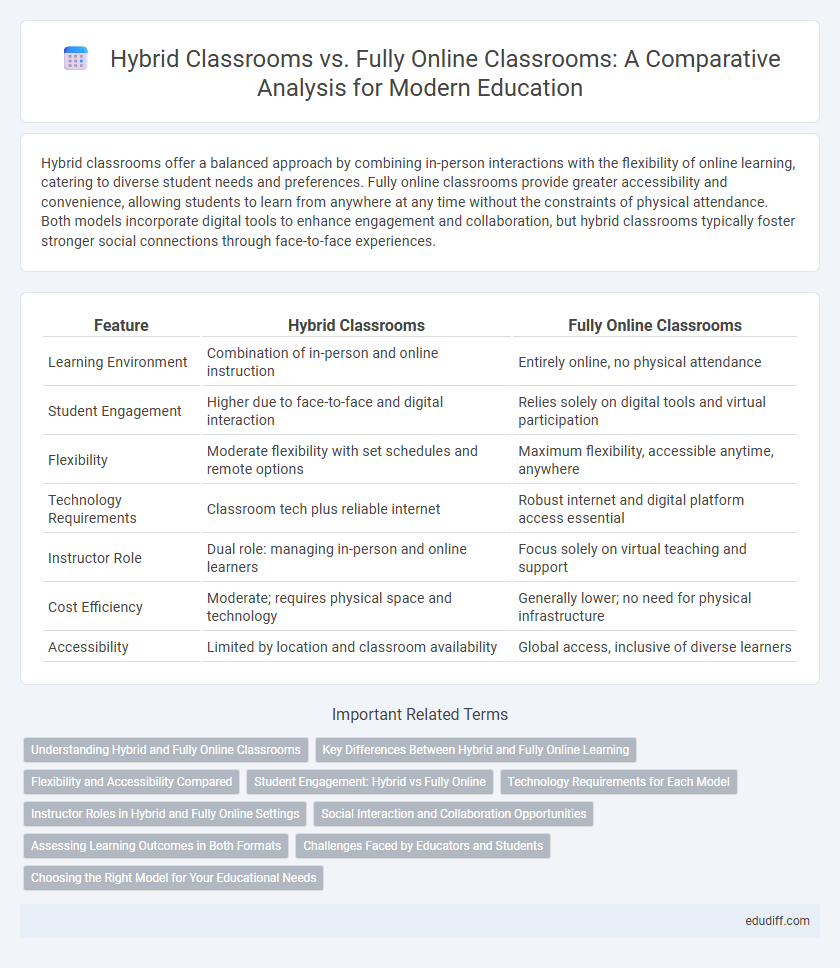Hybrid classrooms offer a balanced approach by combining in-person interactions with the flexibility of online learning, catering to diverse student needs and preferences. Fully online classrooms provide greater accessibility and convenience, allowing students to learn from anywhere at any time without the constraints of physical attendance. Both models incorporate digital tools to enhance engagement and collaboration, but hybrid classrooms typically foster stronger social connections through face-to-face experiences.
Table of Comparison
| Feature | Hybrid Classrooms | Fully Online Classrooms |
|---|---|---|
| Learning Environment | Combination of in-person and online instruction | Entirely online, no physical attendance |
| Student Engagement | Higher due to face-to-face and digital interaction | Relies solely on digital tools and virtual participation |
| Flexibility | Moderate flexibility with set schedules and remote options | Maximum flexibility, accessible anytime, anywhere |
| Technology Requirements | Classroom tech plus reliable internet | Robust internet and digital platform access essential |
| Instructor Role | Dual role: managing in-person and online learners | Focus solely on virtual teaching and support |
| Cost Efficiency | Moderate; requires physical space and technology | Generally lower; no need for physical infrastructure |
| Accessibility | Limited by location and classroom availability | Global access, inclusive of diverse learners |
Understanding Hybrid and Fully Online Classrooms
Hybrid classrooms combine in-person and online learning, enabling flexible participation through both physical presence and virtual access. Fully online classrooms operate entirely through digital platforms, providing remote learners with asynchronous and synchronous instruction without requiring on-site attendance. Understanding the structural differences highlights hybrid models' advantage in fostering direct interaction, while fully online classrooms maximize accessibility and convenience for diverse student populations.
Key Differences Between Hybrid and Fully Online Learning
Hybrid classrooms combine in-person instruction with online learning, enabling real-time interaction and flexibility, while fully online classrooms rely exclusively on digital platforms for content delivery and student engagement. Hybrid learning offers synchronous and asynchronous elements that cater to diverse learning preferences, whereas fully online environments typically emphasize asynchronous modules to accommodate global accessibility. Technology integration in hybrid settings supports collaborative activities and hands-on experiences, contrasting with fully online courses which depend heavily on multimedia resources and virtual assessments.
Flexibility and Accessibility Compared
Hybrid classrooms offer greater flexibility by combining in-person and online learning, allowing students to choose their preferred mode of participation. Fully online classrooms maximize accessibility, enabling learners from diverse geographic locations to engage without physical presence constraints. Both models utilize digital platforms, but hybrid settings provide a balance between face-to-face interaction and virtual accessibility.
Student Engagement: Hybrid vs Fully Online
Hybrid classrooms significantly enhance student engagement by combining in-person interaction with digital flexibility, allowing students to participate actively through face-to-face discussions and online collaborative tools. In contrast, fully online classrooms often face challenges in maintaining engagement due to limited real-time social interaction and reliance on virtual communication platforms. Research indicates that hybrid learning environments improve motivation and participation rates by offering diverse engagement methods tailored to different learning styles.
Technology Requirements for Each Model
Hybrid classrooms require advanced technology such as high-quality cameras, microphones, and interactive whiteboards to facilitate real-time engagement between in-person and remote students. Fully online classrooms depend heavily on robust learning management systems (LMS), reliable video conferencing platforms, and strong internet connectivity to deliver seamless virtual instruction. Both models demand comprehensive IT support and cybersecurity measures to ensure consistent access and protect sensitive student data.
Instructor Roles in Hybrid and Fully Online Settings
In hybrid classrooms, instructors balance in-person engagement with virtual facilitation, requiring adaptability to manage simultaneous interactions and use diverse technological tools. Fully online instructors prioritize creating engaging digital content and fostering interactive virtual environments to maintain student motivation and collaboration solely through online platforms. Both settings demand strong digital literacy and proactive communication skills to support student learning effectively across different modalities.
Social Interaction and Collaboration Opportunities
Hybrid classrooms enhance social interaction by combining face-to-face engagement with digital tools, fostering richer collaboration among students compared to fully online settings. Fully online classrooms rely heavily on virtual platforms, which can limit spontaneous discussions and reduce non-verbal communication cues essential for teamwork. The hybrid model supports diverse interaction modes, increasing peer connection and collaborative learning effectiveness through both physical presence and synchronous digital collaboration.
Assessing Learning Outcomes in Both Formats
Assessing learning outcomes in hybrid classrooms involves combining in-person evaluations with digital assessments to capture both real-time participation and online engagement metrics. Fully online classrooms rely heavily on LMS analytics, timed quizzes, and discussion participation to measure knowledge retention and critical thinking skills. Data-driven insights from both formats help educators identify gaps and tailor instruction for improved student performance.
Challenges Faced by Educators and Students
Hybrid classrooms pose challenges including managing simultaneous in-person and remote students, requiring advanced technology integration and adaptability from educators. Fully online classrooms face difficulties such as maintaining student engagement, ensuring reliable internet access, and overcoming the lack of face-to-face interaction for effective communication. Both modalities demand continuous professional development and innovative teaching strategies to address diverse learning needs.
Choosing the Right Model for Your Educational Needs
Hybrid classrooms combine face-to-face instruction with online learning, offering flexibility and personalized engagement that address diverse student needs. Fully online classrooms provide complete digital access, ideal for learners requiring full remote participation or asynchronous schedules. Selecting the right model depends on factors such as student learning styles, course content complexity, and the importance of real-time interaction.
Hybrid classrooms vs Fully online classrooms Infographic

 edudiff.com
edudiff.com